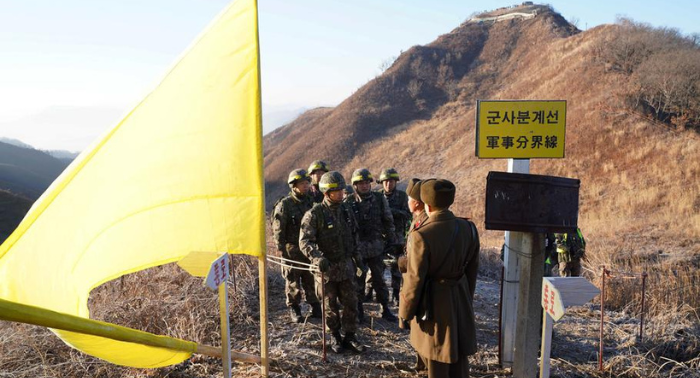In a significant development on the Korean Peninsula, South Korea’s military has reported that North Korea is reconstructing guard posts along the front line that had been previously dismantled during a phase of improved relations between the two countries. This reconstruction comes amid heightened tensions following North Korea’s recent claim of successfully launching a military spy satellite.
Under a 2018 agreement aimed at reducing military tensions, both Koreas had agreed to dismantle or disarm 11 guard posts each within the Demilitarized Zone (DMZ), a heavily fortified border. The pact also included halting certain military exercises and aerial surveillance in designated zones along the DMZ, as well as the removal of some land mines. Following this agreement, South Korea retained 50 border guard posts, and North Korea maintained 150.
However, the accord is now under threat as both nations have indicated their willingness to breach it. The situation escalated after North Korea’s announcement on November 21 of placing its first military spy satellite into orbit. In response, South Korea announced a partial suspension of the deal and the resumption of aerial surveillance along the DMZ, labeling it as “a minimum defensive measure” against North Korea’s growing surveillance and missile capabilities.
North Korea retaliated by declaring its intention to deploy advanced weaponry at the border and no longer adhere to the 2018 agreement. South Korea’s Defense Ministry observed North Korean activities of rebuilding guard posts at previously dismantled locations and deploying troops and heavy weaponry there. Photos distributed by the ministry show North Korean soldiers constructing a guard post and positioning a suspected recoilless rifle in a new trench.
South Korean President Yoon Suk Yeol has instructed the military to closely monitor North Korea and remain vigilant. The Defense Ministry of South Korea has also stated its preparedness to “promptly and strongly punish” any provocations from the North.
The satellite launch by North Korea has drawn strong criticism from South Korea, the United States, and others, who view it as a destabilizing act threatening regional peace. The United Nations Security Council prohibits North Korea from satellite launches, considering them as a disguise for testing long-range missile technology. In contrast, North Korea asserts its right to launch spy satellites in response to perceived military threats from the U.S.
Kim Son Gyong, a senior North Korean Foreign Ministry official, condemned the international criticism of the satellite launch, framing it as an egregious violation of North Korea’s sovereignty. South Korean officials confirmed the satellite’s entry into orbit but are still assessing its operational status.
North Korean state media reported that leader Kim Jong Un reviewed images captured by the spy satellite, including those of a U.S. military facility in Guam. There were also claims of satellite photos of U.S. bases in Hawaii and key South Korean sites, though these images have not been publicly released. Kim Jong Un emphasized the strategic advantage of the satellite, referring to it as providing North Korea with extensive surveillance capabilities.
Experts are skeptical about the satellite’s ability to capture high-resolution images, but they acknowledge its potential military utility for North Korea. There is suspicion in South Korea that Russian technology may have aided North Korea’s satellite launch. Accusations have been leveled against North Korea of seeking advanced Russian technologies for its military programs in exchange for supplying arms to Russia for the conflict in Ukraine, a claim denied by both Russia and North Korea.




